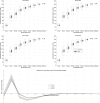Large Scale Population Assessment of Physical Activity Using Wrist Worn Accelerometers: The UK Biobank Study
- PMID: 28146576
- PMCID: PMC5287488
- DOI: 10.1371/journal.pone.0169649
Large Scale Population Assessment of Physical Activity Using Wrist Worn Accelerometers: The UK Biobank Study
Abstract
Background: Physical activity has not been objectively measured in prospective cohorts with sufficiently large numbers to reliably detect associations with multiple health outcomes. Technological advances now make this possible. We describe the methods used to collect and analyse accelerometer measured physical activity in over 100,000 participants of the UK Biobank study, and report variation by age, sex, day, time of day, and season.
Methods: Participants were approached by email to wear a wrist-worn accelerometer for seven days that was posted to them. Physical activity information was extracted from 100Hz raw triaxial acceleration data after calibration, removal of gravity and sensor noise, and identification of wear / non-wear episodes. We report age- and sex-specific wear-time compliance and accelerometer measured physical activity, overall and by hour-of-day, week-weekend day and season.
Results: 103,712 datasets were received (44.8% response), with a median wear-time of 6.9 days (IQR:6.5-7.0). 96,600 participants (93.3%) provided valid data for physical activity analyses. Vector magnitude, a proxy for overall physical activity, was 7.5% (2.35mg) lower per decade of age (Cohen's d = 0.9). Women had a higher vector magnitude than men, apart from those aged 45-54yrs. There were major differences in vector magnitude by time of day (d = 0.66). Vector magnitude differences between week and weekend days (d = 0.12 for men, d = 0.09 for women) and between seasons (d = 0.27 for men, d = 0.15 for women) were small.
Conclusions: It is feasible to collect and analyse objective physical activity data in large studies. The summary measure of overall physical activity is lower in older participants and age-related differences in activity are most prominent in the afternoon and evening. This work lays the foundation for studies of physical activity and its health consequences. Our summary variables are part of the UK Biobank dataset and can be used by researchers as exposures, confounding factors or outcome variables in future analyses.
Conflict of interest statement
DJ is a director of Axivity Ltd who manufactured the accelerometer used in our study. PO has previously been a director of Axivity Ltd. NH has previously consulted for Axivity Ltd. The partners of DJ and PO own shares in Axivity. This does not alter our adherence to PLOS ONE policies on sharing data and materials.
Figures







References
-
- Chief Medical Officers of England, Scotland, Wales, and Northern Ireland. Start Active, Stay Active: A report on physical activity for health from the four home countries. U.K. Department of Health; 2011.
-
- Steene-Johannessen J, Anderssen SA, van Der Ploeg HP, Hendriksen IJM, Donnelly AE, Brage S, et al. Are Self-report Measures Able to Define Individuals as Physically Active or Inactive? Med Sci Sport Exerc. 2016;48 Available: http://journals.lww.com/acsm-msse/Fulltext/2016/02000/Are_Self_report_Me... - PMC - PubMed
-
- Strath SJ, Kaminsky LA, Ainsworth BE, Ekelund U, Freedson PS, Gary RA, et al. Guide to the assessment of physical activity: Clinical and research applications: a scientific statement from the American Heart Association. Circulation. 2013;128: 2259–79. 10.1161/01.cir.0000435708.67487.da - DOI - PubMed
MeSH terms
Grants and funding
LinkOut - more resources
Full Text Sources
Other Literature Sources
Medical

